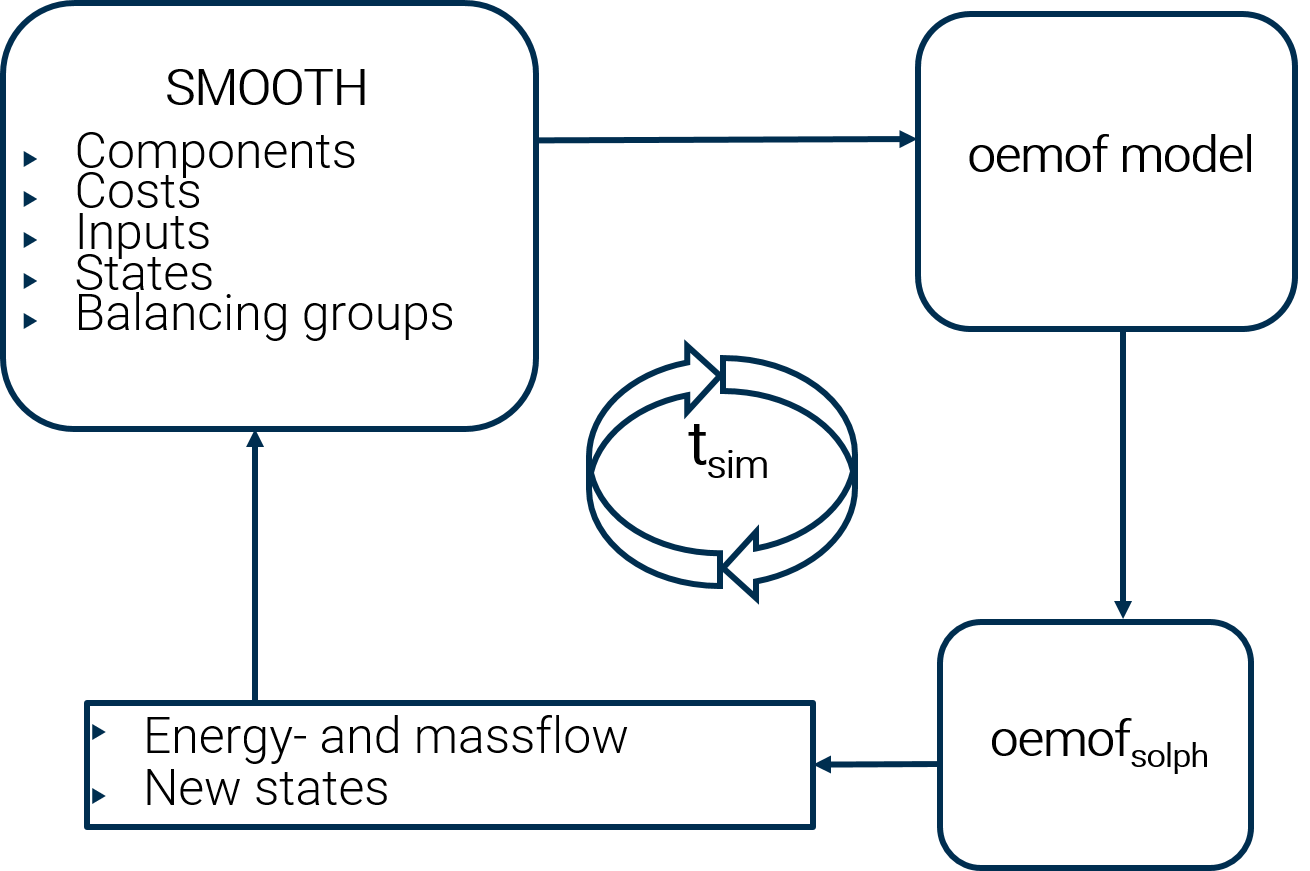smooth.framework package¶
Subpackages¶
- smooth.framework.functions package
- Submodules
- smooth.framework.functions.calculate_external_costs module
- smooth.framework.functions.debug module
- smooth.framework.functions.functions module
- smooth.framework.functions.load_results module
- smooth.framework.functions.plot_results module
- smooth.framework.functions.print_results module
- smooth.framework.functions.save_results module
- smooth.framework.functions.update_annuities module
- smooth.framework.functions.update_fitted_cost module
- Module contents
Submodules¶
Run SMOOTH¶
This is the core of smooth. It solves (M)ILP of an energy system model for discrete time steps using the Open Energy Modelling Framework solver (oemof-solph).
How to use¶
The run_smooth() function expects an energy model. Such a model consists of:
- energy sources
- energy sinks
- energy transformers
- buses to transport energy
Additionally, simulation parameters are needed to run the model.
A model is therefore defined as a dictionary containing all components,
buses (grouped as busses) and simulation parameters (grouped as sim_params,
see smooth.framework.simulation_parameters.SimulationParameters).
Example:
{
components: {
name_of_first_component: {
component: ...,
capex: ...,
opex: ...,
...
},
...
},
busses: [
name_of_first_bus,
name_of_second_bus,
...
],
sim_params: {
start_date: ...,
n_intervals: ...,
interval_time: ...,
interest_rate: 0.03,
...
}
}
Note
Legacy models (version < 0.2.0) define their components as a list with an extra field name for each component. This is deprecated.
Result¶
Two items are returned. The second is a string describing the oemof solver return status. You want this to be ‘ok’, although other values are possible. The first item returned is a list of all components, each updated with
sim_params: the original simulation parameters, plus date_time_index for each time step and sim_time_span in minutes
results: results from the simulation
- variable_costs*
- art_costs*
- variable_emissions*
- annuity_capex
- annuity_opex
- annuity_variable_costs
- annuity_total
- annual_fix_emissions
- annual_op_emissions
- annual_variable_emissions
- annual_total_emissions
states: dictionary with component-specific attributes. Each entry is a list with values for each time step
flows: dictionary with each flow of this component. Key is tuple (from, to), entry is list with value for each time step
data: pandas dataframe
(component-specific attributes)
* a list with a value for each time step
Implementation¶
The concept of run_smooth() is demonstrated in the figure below:
The run_smooth() function has three distinct phases:
initialization, simulation and post processing.
Initialization¶
There is not much to see here. Mainly, component instances get created from the model description. For legacy models (version < 0.2.0), the component list is converted to a dictionary. No oemof model is built here.
Simulation¶
This is the main part of the function. For each time step, an oemof model is solved and evaluated:
print current time step to console if print_progress is set in parameters
initialize oemof energy system model
create buses
update components and add them to the oemof model
update bus constraints
write lp file in current directory
call solver for model
check returned status for non#.optimal solution
handle results for each component
- update flows
- update states
- update costs
- update emissions
Post-processing¶
After all time steps have been computed, call the generate_results function of each component. Finally, return the updated components and the last oemof status.
-
smooth.framework.run_smooth.run_smooth(model)¶ Runs the smooth simulation framework
Parameters: model (dictionary) – smooth model object containing parameters for components, simulation and busses Returns: results of all components and oemof status Return type: tuple of components and string Raises: SolverNonOptimalError if oemof result is not ok and not optimal
Simulation Parameters¶
-
class
smooth.framework.simulation_parameters.SimulationParameters(params)¶ Bases:
objectClass to store parameters for smooth simulation.
Parameters: - start_date (string representation of date) – the first evaluated time period. Defaults to ‘1/1/2019’
- n_intervals (integer) – number of time steps. Defaults to 24*7=168
- interval_time (integer) – length of one time step in minutes. Defaults to 60 (one hour)
- interest_rate (float) – Interest rate for calculating annuity out of CAPEX. Defaults to 0.03 (3%)
- print_progress (boolean) – Decide if the running progress should be printed out. Defaults to False
- show_debug_flag (boolean) – Decide if last result values should be shown in case solver was not successful. Defaults to True
Variables: - date_time_index – pandas date range of all time periods to be evaluated
- sim_time_span – length of simulation time range in minutes
-
set_parameters(params)¶ Helper function to set simulation parameters on initialisation.
Parameters: params (dictionary) – parameters to set Raises: ValueError for unsupported simulation parameters
